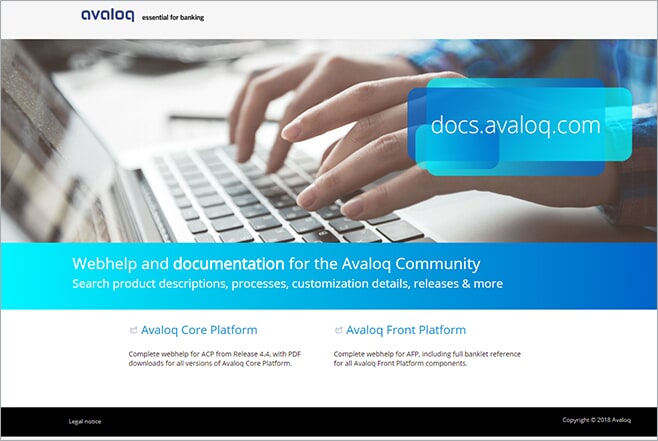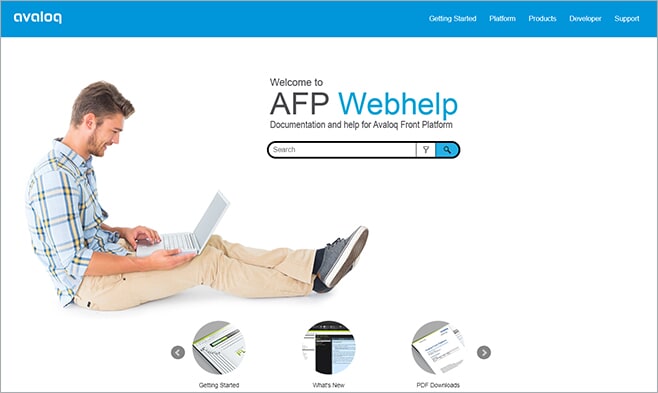Customer Success Story
Avaloq, a Leader in Integrated Banking Solutions, Replaces Legacy Content Management System with MadCap Flare to Produce Modern HTML5-Based Online Help
Goals
- Migrate from a legacy DITA-based authoring system and CMS (Schema ST4) to software optimized for publishing modern, HTML5-based content.
- Facilitate more efficient development and delivery of Avaloq’s documentation through content reuse and single-source, multi-channel publishing.
- Design a modern Help website that aligns with the Avaloq brand and creates an intuitive and appealing experience for users.
- Make it easier for users to navigate and find the information they need.
Benefits
- Efficiency: Flare’s topic-based single-source publishing facilitates content reuse and streamlines the creation and delivery of an HTML5-based Help website plus supporting PDFs.
- Collaboration: MadCap Flare integration with Git fosters collaboration and provides version control of content. MadCap Contributor lets SMEs review and add content.
- Intuitive User Experience: HTML5 navigation, Google-like search, consistent structuring and links all help towards providing a modern, interactive web experience.
- Easy Customization: Conditional tags and cascading style sheets in Flare enable Avaloq to customize multiple online outputs with minimal effort. Open nature of MadCap Flare’s ecosystem allows easy and rapid enhancements that benefit both writers and end-users alike.
MadCap Software Solutions and Services:
Avaloq is a leader in core banking software and digital technology, and a provider of software as a service (SaaS) and business process as a service (BPaaS) solutions for banks and wealth managers.
Headquartered in Switzerland, Avaloq has branches in the most demanding financial centers worldwide and serves over 150 banks and wealth managers. Avaloq’s growing ecosystem comprises among others over 2,000 employees and more than 500 third-party developers that co-innovate with Avaloq.
At the heart of the company’s solutions is the Avaloq Banking Suite: a fully integrated, modular banking and wealth management service covering back, middle and front office functionality.
Today, Avaloq relies on MadCap Flare to deliver HTML5-based online Help to its customers. It provides users with a modern web experience that aligns with and complements the company’s main website. Using Flare’s topic-based authoring and single-source, multi-channel publishing capabilities, Avaloq has streamlined the process of publishing PDFs that accompany the online Help, letting users access information in their format of choice.

Welcome Page of Avaloq’s HTML5-based Help Site
Modernizing Documentation Delivery
Previously, Avaloq used an XML component content management system (CCMS), to generate traditional PDF documentation based on the Darwin Information Typing Architecture (DITA) open standard but heavily customized for historical Avaloq requirements. These PDFs then had to be manually uploaded to a web CMS made available to the Avaloq community behind a secure login making the system cumbersome to update and maintain.
“We had thousands of PDF documents we needed to produce for the Avaloq community, with hundreds of documents published per release across at least 10 different document types,” recalled Jeremy White, head of technical communication at Avaloq. “Our CCMS was slow and sometimes unusable; it was becoming increasingly inefficient to make documentation updates and produce complete doc sets for each release. We were often spending more time administering the system than writing and editing content!”
Additionally, Avaloq wanted to provide a richer, modern experience for users accessing its documentation. The first step for the Avaloq docs team was conducting a customer satisfaction survey to get feedback on documentation pain points. Responses confirmed that the documents, which had no links between them, were too long and overwhelming to look through, and the quality of content was inconsistent. In short: most users wanted a simpler and quicker way to find their information.
With the user feedback in hand, the team decided to reinvent its documentation as modern, HTML5-based online Help. Additionally, they wanted to move to new software that would support topic-based authoring and single-source publishing to multiple outputs so that they could streamline the process of creating and delivering this content.
We knew MadCap Flare would give usability, flexibility, and control back to our writers. We also liked that Flare gave us the functionality we needed at a fraction of the annual charge we were paying for our legacy CMS.
Jeremy White Head of Technical Communication, Avaloq

Avaloq Custom App Helps Migration to Flare
The Avaloq team evaluated several authoring solutions, and MadCap Flare emerged as the solution of choice for Avaloq’s move to a user-friendly online Help website.
“With some previous Flare experience in our team, we knew that Flare ticked a lot of boxes, especially single-sourcing features, support for external version control, the ability to link documents, and enhanced search capabilities,” White explained. “We knew Flare would give usability, flexibility, and control back to our writers. We also liked that Flare gave us the functionality we needed at a fraction of the annual charge we were paying for our legacy CCMS.”
Faced with moving more than 5,000 of its PDF documents into MadCap Flare, the Avaloq team considered two options: either import DITA into Flare or transform the XML themselves. The team decided to build a custom application, as this would give them full control over the migration process, with Flare projects as the output. “We knew Flare used open standards,” said White, “And its project files could be created externally with not too much effort thanks to Flare’s ‘plug and play’ nature.”
The resulting application, named ST42Flare, uses an Extensible Stylesheet Language Transformations (XSLT) processor to convert collections of published Extensible Markup Language (XML) to Extensible Hypertext Markup Language (XHTML), and then creates Flare projects. With a legacy database over 60 GB in size, the big challenge was scale: on completion, ST42Flare used 3,100 lines of XSLT scripts and 60,000 lines of batch code to process over 100,000 modules and 50,000 images.
“With our ST42Flare app, we extracted and transformed collections of legacy content into Flare projects and used Madbuild to automatically create the PDF and HTML5 outputs. This gave us more control than if we had just imported the DITA XML into the HTML5 output and launched it. We rationalized a lot of the semantic tagging and spent time ensuring the HTML output looked good, made content easy to find and delivered a high standard of usability.”

Welcome Page of Help Site for Avaloq Front Platform
Single-Source Publishing with MadCap Flare
Today, Avaloq’s technical writers provide customers with a modern, HTML5-based Help website containing documentation on how to effectively use and customize Avaloq products.
By taking advantage of MadCap Flare’s topic-based single-source publishing, the team has been able to simplify the process of developing and delivering their documentation. Flare features, such as snippets, variables, and conditional text help the writers maximize content reuse for its different outputs.
“Flare snippets and variables are huge time-saving features for us. When we want to change product names for future versions or releases, we can automate these updates just by changing the variables,” White observed. “It enables us to produce a more consistent quality of content. And snippets help us manipulate and enter content faster than before.”
To help existing customers adapt to the new platform, Avaloq continue to provide PDF documents to complement the web content. Using conditional tags In MadCap Flare, a project’s front matter and internal links are all tagged to output differently depending on whether HTML or PDF output is being published.
“With Flare’s conditional tags, we’re able to generate different versions of the same content,” said White. “This is super useful since we have PDF content that isn’t published online and vice versa.”
The ease of single-sourcing from MadCap Flare is a huge benefit to Avaloq’s technical writers, and conditional tags have drastically reduced the time it takes them to implement content changes across different outputs.
“We can now customize content with little effort, while maximizing productivity,” said White.
Our Flare-based documentation ecosystem has opened up many new possibilities that can benefit both our own creators and our customers.
Jeremy White Head of Technical Communication, Avaloq
Controlling the Source with Git
One thing Avaloq’s tech writers needed from the get-go was compatibility with standard version control systems, in particular Git.
“We have to maintain and update several versions of the same documentation for a software release at any one time, which adds a lot of complexity when we build in new features for a product,” said White. “Because MadCap Flare plays nice with Git, we can be much more efficient than before in implementing new features and simultaneously publishing different versions of a product release.”
The ease with which MadCap Flare fits into Avaloq’s corporate IT infrastructure has meant existing tools and processes were easy to leverage and link to. By taking advantage of commonly-used and understood IT practices like Git source control, Avaloq’s writers have made it even easier to work with their development teams and subject matter experts (SMEs).
Cultivating Collaboration with MadCap Contributor
Avaloq’s growth has led to expanded and more-frequently updated product offerings, increasing the need for online Help. MadCap Contributor, which is fully integrated with MadCap Flare, enables writers and SMEs to easily share, review, and contribute content to a Flare project.
“Contributor has streamlined and simplified the process of making changes across large areas of content for our team of writers,” White said. “It’s quick and simple to share draft content with our SMEs, and they love how easy it is to pick up and use Contributor.”
White added, “As Avaloq’s agile approach means more frequent software deliveries, MadCap Flare gives us the flexibility and usability to deliver richer content faster and more frequently, and helps us quickly align with product and company changes.”
Because MadCap Flare plays nice with Git, we can be much more efficient than before in implementing new features and simultaneously publishing different versions of a product release.
Jeremy White Head of Technical Communication, Avaloq
Fostering Innovation and Customization
Avaloq have been able to encourage innovation and support customization by leveraging features in MadCap Flare such as skins, cascading style sheets (CSS), and global master projects.
“We use Flare’s skin and CSS editors to apply our company branding and style guidelines at the ground level,” said White. “This way, our online Help and documentation is always aligned with the latest corporate look-and-feel.”
Avaloq use different skin types to suit the published topic: the team found Flare’s top-navigation output ideal for the front-end documentation, while for core engine information a tri-pane skin was used as this better suited the design and volume of topics migrated from the legacy CCMS.
CSS functionality allows the team to make multiple format changes all at once in one place. As a result, the writers can focus more on creating enriching content instead of constantly formatting and reformatting like before.
“The CSS feature gives us a lot of flexibility to arrange content quickly and republish whenever we make small changes, which helps us to be much more responsive in keeping pace with corporate brand or product changes,” White said. “We couldn’t restructure documents easily with our previous tool. Now, with Flare we have much more control and can align our content delivery more closely with the product.”
Avaloq maintains a global master project with custom templates containing all the “compliant” skins, style sheets and product names.
“As style requirements change, we can update our master project in one place, and this gets pushed automatically to all our tech writers and SMEs using Flare. This would be whole lot harder to do without MadCap Flare’s project features.”
White continued, “Our SMEs sometimes want to give us source material in alternative formats, like wiki pages or Microsoft® Word files. Flare’s import options give us the freedom to accept these easily into projects, then publish them along with information written in Flare directly. The reader has a seamless experience either way.”
Our web content appears uncluttered and intuitively organized thanks to Flare’s navigation; it also allows us to innovative the Help website and enhance the user experience.
Jeremy White Head of Technical Communication, Avaloq
Enhanced User Experience
By publishing in HTML5, Avaloq’s writers have achieved a clean, modern look-and-feel with their online Help. This has helped to create a more seamless and intuitive web experience for customers.
“Our web content appears uncluttered and intuitively organized thanks to Flare’s navigation,” White explained.
To make it easier for users to access information, Avaloq also relies on features in Flare such as thumbnail images, integrated video, and search functionality.
“The ability to display images as thumbnails that can be viewed full-size when users hover over them helps us present content in short and condensed format,” White noted. “Some of our diagrams contain a lot of information, so it’s handy to get the big picture!”
We use Flare’s skin and CSS editors to apply our company branding and style guidelines at the ground level. This way, our online Help and documentation is always aligned with the latest corporate look-and-feel.
Jeremy White Head of Technical Communication, Avaloq
Meanwhile, multimedia support in MadCap Flare allows for a more interactive experience.
“Being able to easily embed videos and YouTube links in Flare is a great feature that lets users learn in the format of their choice,” White explained. “To help launch the new site, we recorded some short video tours and put these on the homepage. Making a short intro video for a new feature and connecting it to the content has a much better impact than explaining it with just words.”
Central to the overall online Help approach was the Google-style search bar provided with MadCap Flare, which gives customers a fast and familiar way to find the information they need.
“Flare’s advanced search functionality has been a huge plus for our users, which was one of the driving factors for reinventing our approach to documentation delivery,” White said.
“Before, users had to find the right PDF document and were then expected to read through the entire document just to find what they were looking for. Now they can do a quick search and immediately jump to the correct topic.”
Additionally, Avaloq has exploited MadCap Flare’s open architecture to deliver small enhancements and requested updates to the help system.
“It’s so easy with MadCap Flare to drop in extra elements to the page, like code highlighting or sortable tables,” said White. “We can quickly and cheaply source, test, and deploy small improvements like this in a way that we never could before.”
As Avaloq’s agile approach means more frequent software deliveries, MadCap Flare gives us the stability and flexibility to accelerate the documentation release cycle in tandem. We can now deliver richer content faster, ensuring product innovations are documented and easy to find.
Jeremy White Head of Technical Communication, Avaloq
Expanding Use of MadCap Flare
The TCOM team proved the concept of Flare-produced Avaloq documentation with the launch of online Help for the web-enabled components of the Avaloq Banking Suite. “All we had to do then was scale it up for our core documentation,” said White. “The challenge was fitting it all together as one coherent help structure.”
To assist, the team took advantage of advanced features in MadCap Flare, most notably master projects and Global Project Linking (GPL).
“Because there was much more documentation required for the core software, it wasn’t feasible to have just one project for all the documents,” White explained. “Factor in multiple tech writers, and you also need an easy way to collaborate. So we created a master project in Flare with multiple projects linked underneath it. We then used the Flare GPL functionality to publish all the projects as one output. We use a “master builder” project to integrate and publish from different Git branches that represent each software version. We wrote a wee script to pull all updates from Git and then publish from Flare automatically. The ability to integrate standard open tools and technologies like this was a big attraction of using MadCap Flare,” said White.
While building their new online Help system, Avaloq’s writing team also collaborated with colleagues in other parts of the business. “Our docs team focused on migrating and providing online Help for product documentation,” said White, “But other teams within the company are increasingly interested in the possibilities offered by MadCap Flare and MadCap Contributor. Our new Flare-based documentation ecosystem has opened up many new possibilities that can benefit both our own creators and our customers.”
Recalling the original customer satisfaction survey, Avaloq’s Jeremy White is keen to update the numbers.
“When my former manager Oliver Howell and I were analyzing the survey, we saw a trend of frustration that we knew we could address with the right approach. Now we’ve upgraded to MadCap Flare, and we’re delivering searchable, on-demand HTML5-based online Help to our global community. We’re now perfectly positioned to track and adapt to the changing documentation needs of our customers in a way we never could before.”





